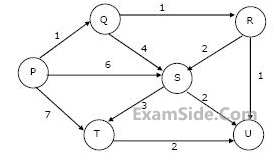1
GATE CSE 2004
MCQ (Single Correct Answer)
+2
-0.6
Suppose we run Dijkstra’s single source shortest-path algorithm on the following edge-weighted directed graph with vertex P as the source.
 In what order do the nodes get included into the set of vertices for which the shortest path distances are finalized?
In what order do the nodes get included into the set of vertices for which the shortest path distances are finalized?
 In what order do the nodes get included into the set of vertices for which the shortest path distances are finalized?
In what order do the nodes get included into the set of vertices for which the shortest path distances are finalized?2
GATE CSE 2003
MCQ (Single Correct Answer)
+2
-0.6
What is the weight of a minimum spanning tree of the following graph?


3
GATE CSE 2003
MCQ (Single Correct Answer)
+2
-0.6
Let G=(V,E) be an undirected graph with a subgraph G1=(V1,E1). Weights are assigned to edges of G as follows.
$$$w(e) = \begin{cases} 0 \text{, if } e \in E_1 \\1 \text{, otherwise} \end{cases}$$$
A single-source shortest path algorithm is executed on the weighted graph (V,E,w) with an arbitrary vertex v1 of V1 as the source. Which of the following can always be inferred from the path costs computed?
4
GATE CSE 2003
MCQ (Single Correct Answer)
+2
-0.6
Let G = (V, E) be a directed graph with n vertices. A path from vi to vj in G is sequence of vertices (vi, vi+1, ……., vj) such that (vk, vk+1) ∈ E for all k in i through j – 1. A simple path is a path in which no vertex appears more than once.
Let A be an n x n array initialized as follow
$$$A[j,k] = \left\{ {\matrix{ {1\,if\,(j,\,k)} \cr {1\,otherwise} \cr } } \right.$$$ Consider the following algorithm.
$$$A[j,k] = \left\{ {\matrix{ {1\,if\,(j,\,k)} \cr {1\,otherwise} \cr } } \right.$$$ Consider the following algorithm.
for i = 1 to n
for j = 1 to n
for k = 1 to n
A [j , k] = max (A[j, k] (A[j, i] + A [i, k]); Questions Asked from Marks 2
GATE CSE 2025 Set 2 (1) GATE CSE 2025 Set 1 (1) GATE CSE 2024 Set 2 (2) GATE CSE 2021 Set 2 (1) GATE CSE 2020 (2) GATE CSE 2018 (2) GATE CSE 2016 Set 1 (2) GATE CSE 2015 Set 2 (1) GATE CSE 2015 Set 1 (1) GATE CSE 2014 Set 2 (2) GATE CSE 2012 (1) GATE CSE 2011 (2) GATE CSE 2010 (2) GATE CSE 2009 (1) GATE CSE 2008 (1) GATE CSE 2007 (4) GATE CSE 2006 (1) GATE CSE 2004 (1) GATE CSE 2003 (3) GATE CSE 2000 (1) GATE CSE 1992 (1) GATE CSE 1991 (2)
GATE CSE Subjects
Theory of Computation
Operating Systems
Algorithms
Digital Logic
Database Management System
Data Structures
Computer Networks
Software Engineering
Compiler Design
Web Technologies
General Aptitude
Discrete Mathematics
Programming Languages
Computer Organization